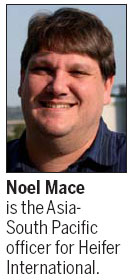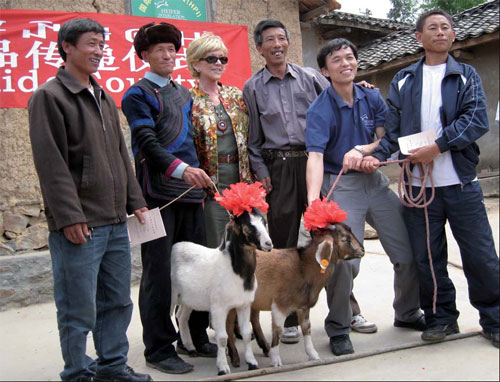Charity begins in cowshed
Updated: 2012-08-24 07:41
By Jonathan Stefonek (China Daily)
|
||||||||
|
Chen Taiyong, second from right, with a charity donation of goats to a farm family. Provided to China Daily |
For one aid group, an animal on the farm is worth more than a meal on the table
The idea sounds simple enough: You buy an animal, then give it to a family, the animal makes money, then it has a baby and the baby goes to another family. Poverty solved.
That, at least, is the way Alton Brown, the host of Food Network's Good Eats and Iron Chef America, explains it, but the logistics behind the mission of Heifer International, Arkansas, is a lot more complex than that.
"We had a whole period where we had seafaring cowboys," says Noel Mace, the Asia-South Pacific officer for Heifer International, an Ozark twang occasionally coming through as he talks. But the task was even more inefficient than it sounds.
"They took a bunch of cattle and put them on boats, and took them all over the world."
The idea started, Mace says, when their founder Dan West, a peace activist during the Spanish Civil War, was handing out powdered milk and saw the milk run out before the line of children did. This led him to this conclusion: these people don't need milk, they need a cow.
"Dan West went to dairy farmers he knew and he said 'Hey, give me a cow. And I'll ship it to these guys that need a cow,' Mace says. Soon enough, in 1946, 550 head of cattle landed in China all the way from Pennsylvania.
After a break in operations, the connection with China was re-established in 1984, and Chen Taiyong became involved. But the first shipment did not come without problems.
"Heifer shipped 200 rabbits from the US, but when they arrived, almost half of the rabbits had died," Chen says. Despite the loss of so many animals, Chen says the introduction of new breeds and genetic diversity was the most important contribution. Once they arrived, the rabbits multiplied the way rabbits do. Today Heifer gets locally sourced animals, which spares them from the arduous Pacific voyage.
This approach to dealing with poverty faces additional challenges beyond the frailty and sometimes short lifespans of their donations. The organization started through the donation of one small part of an American farm to jump-start family farms a world away.

Today in the US, the viability of the family farm is constantly in question. In 2010, according to a US Department of Agriculture report, "America's Diverse Family Farms", 12 percent of the farms in the US were responsible for 84 percent of agricultural production.
In recent years, a number of the companies that pioneered high-production and high-efficiency techniques in the US have invested in developing China's domestic food production.
The National Bureau of Statistics of China has reported a more than threefold increase in investment in agriculture between 2005 and 2010, totaling 792 billion yuan ($124.5 billion). Over the same time, foreign investment in China's agriculture increased from 1.32 billion to 2.75 billion yuan.
In June, China Daily reported that Wuhan Iron and Steel (Group) Corporation would be diversifying into agricultural ventures, including a pork production facility holding up to 10,000 hogs.
Food security has become a focus of China's central government, highlighted this year by a visit by Vice-President Xi Jinping to Iowa. He was the guest of honor at an agricultural symposium in the state capital, Des Moines. Also in attendance was the director of Iowa State University's Egg Industry Center, Professor Xin Hongwei.
"Increasing the efficiency of production is definitely one of the top priorities the government wanted to pursue," Xin says, describing Xi's speech.
To show the change in demand and production, Xin cited changes over the past 50 years.
"In 1960 you're looking at about just barely 4 million metric tons of total animal protein production and in 2010 we're looking at 130 million," Xin says. "That's about 32 times as much. And that trend continues to grow."
In the market it is difficult for small farms to compete against economies of scale to the tune of thousands of animals, but the Chinese family farm also has its own particular ways of getting ahead.
"There are still a lot of people looking for stuff produced locally by small-scale farmers, producing in different ways," Mace says. "We take advantage of those markets."
Not having invested totally in raising a single animal also allows these small farmers to be much more flexible in case conditions are less than ideal.
"Because of the drought they are addressing: Can you do grass-fed? How can you alter your husbandry techniques? How can you take care of the animals? And if this carries on, people are going to have to find alternative livestock that they are going to take care of."
The droughts have tested many Chinese farmers this year, but Huang Lingli, a PhD candidate at Johns Hopkins University in Maryland, says it is not nearly so bad compared with two years ago.
"The problem was so serious that the government had to subsidize farmers to encourage them to grow wheat, but also to subsidize them for the water," she says.
Huang has returned to China for the next year to do field research for her dissertation on water usage in China. Her interest in the topic started when she was growing up in the country and she learned from her father, an agricultural engineer.
"I remember him saying that irrigation was quite good early on," Huang says. "Peasants were mobilized to work together to build a very comprehensive irrigation system from scratch."
Over time, economic growth was an increasing priority, and as a result, Huang says, little, if any, focus was placed on water resources.
Whether or not Heifer International's procedures are using any of the same historical reference points as Huang, they require a supportive local community. Heifer develops what it calls self-help groups - 15 to 25 working together toward a sustainable agricultural community.
"That's really so we can get long-lasting change, but in a group environment where they are supporting one another," Mace says. "I compare it to a classroom. I've had classrooms of 15 people, and I've had classrooms of 150 people. And in a group of 15 everybody knows one another, they are able to support one another and work together. It gives everyone opportunities to develop leadership skills."
Heifer is able to get farmers started with animals, offer training, help them find a competitive advantage and even connect them with companies like Dannon Yogurt. But ultimately, Chen says, "Nobody can guarantee everything."
China Daily

 'Taken 2' grabs movie box office crown
'Taken 2' grabs movie box office crown
 Rihanna's 'Diamonds' tops UK pop chart
Rihanna's 'Diamonds' tops UK pop chart
 Fans get look at vintage Rolling Stones
Fans get look at vintage Rolling Stones
 Celebrities attend Power of Women event
Celebrities attend Power of Women event
 Ang Lee breaks 'every rule' to make unlikely new Life of Pi film
Ang Lee breaks 'every rule' to make unlikely new Life of Pi film
 Rihanna almost thrown out of nightclub
Rihanna almost thrown out of nightclub
 'Dark Knight' wins weekend box office
'Dark Knight' wins weekend box office
 'Total Recall' stars gather in Beverly Hills
'Total Recall' stars gather in Beverly Hills
Most Viewed
Editor's Picks

|

|

|

|

|

|
Today's Top News
Health new priority for quake zone
Xi meets US top military officer
Japan's boats driven out of Diaoyu
China mulls online shopping legislation
Bird flu death toll rises to 22
Putin appoints new ambassador to China
Japanese ships blocked from Diaoyu Islands
Inspired by Guan, more Chinese pick up golf
US Weekly

|

|







